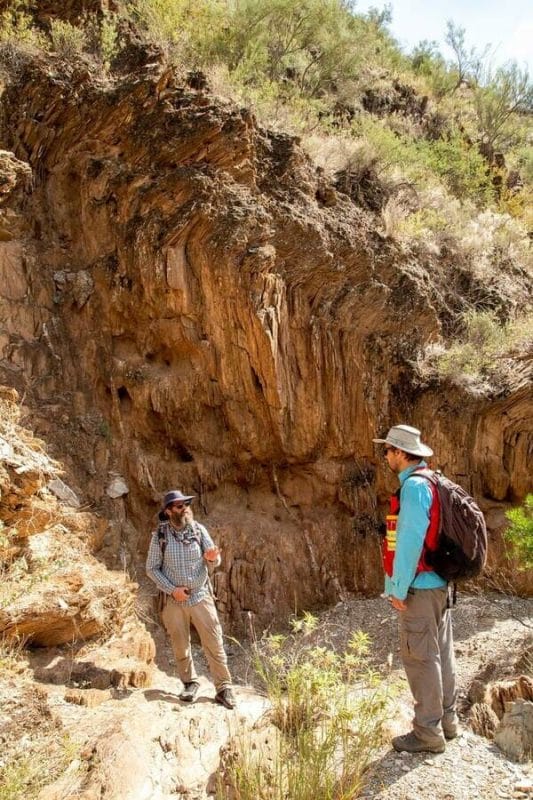‘Gold-rich zone‘ – ‘Open-ended mineralization‘ – ‘Areas previously untested by historic drilling‘… when a junior explorer trots out this kind of wordage in the intro of a communique, pay attention to the details that follow.
When the crew behind such phrasing is top shelf—a crew not prone to puffery or hyperbole—pay close attention to the details that follow.
An example—a recent headline out of the Arizona Metals camp:
“Arizona Metals Corp. (AMC.V, AZMCF.OTCQX) is pleased to announce the results of an additional ten drill holes at the recently discovered gold-rich zone of open-ended mineralization at the Kay Mine, in areas previously untested by historic drilling or exploration.”
You may have also noticed assay values in the text of the headline—this is another positive lead. In this case, closer attention is definitely warranted.
The grades and widths presented in the above headline are impressive. Note the copper and gold values.
Twenty-four meters grading 5.0% Cu, 0.6 g/t Au, 1.0% Zn, and 23 g/t Ag is rich rock—coppers recent price trajectory offers some context regarding just how rich.

Arizona Metals’ flagship project—the Kay Mine Project—is located in a world-class mining-friendly jurisdiction currently ranked #2 by the esteemed Fraser Institute (Arizona currently leads the U.S. in copper production).
Investment Attractiveness Index (published Q1, 2021)
The extraordinary mineral endowment of this district gave rise to no less than 60 underground Cu-Au-Zn mines during its century-long run.

~4 billion pounds of copper was produced, all within a 150-kilometer radius of the Company’s flagship.
These deposits were formed via a series of volcanic hydrothermal events along seafloor beds when tidal H2O enveloped the region. These are what’s known as Volcanic Massive Sulphide (VMS) deposits.
Everything You Need to Know about VMS
High-quality VMS deposits are on the radar of every resource-hungry producer looking to bulk up its project pipeline (pipelines made lean by the brutal bear market of the past decade).
Why are these deposits so highly prized? Though they vary in scale—from < one million tons all the way to up to 100 million—these polymetallic orebodies often hold huge concentrations of metals due to their rich nature.
The right VMS orebody can be a company-maker.
And as you may already know, especially if you’ve been following this rapidly evolving exploration/development play for any length of time, VMS deposits rarely occur in isolation. They almost always occur in clusters—where there’s one deposit (or lens), there are often others.
The grandsire of this prolific VMS district was United Verde—30 million tons (Mt) at 5% copper PLUS an extension deposit that produced 3.5Mt at 10.2% Cu, 1.3 g/t Au, and 58 g/t Ag (fabulously rich rock y’all).
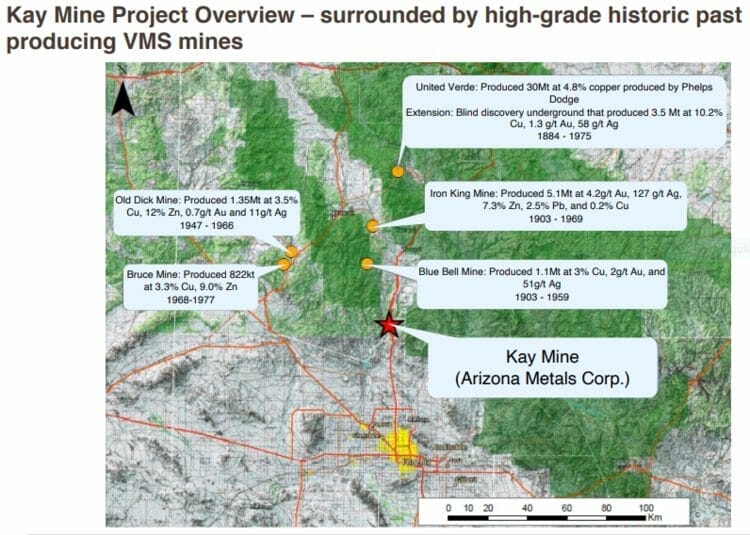
The Kay Mine Project carries a (historical) resource courtesy of Exxon Minerals back in the day (the early 1980s).
Exxon reported a “proven and probable reserve of 6.4 million short tons grading 2.2% copper, 2.8 g/t gold, 3.03% zinc, and 55 g/t silver.” ***
To blow the doors open on this project—to bring these historic pounds-in-the-ground into 43-101 compliance (and then some)—the Company is pushing Kay aggressively along the curve and is currently in the midst of a 75,000-meter Phase-2 drill program—a campaign that was accelerated back in June with the addition of a third drill rig.
Back to the October 12th headline…
This recently discovered gold-rich zone of open-ended mineralization (in areas previously untested by historic drilling), generated the following highlights:
(true width of mineralization is estimated to be 50% to 97% of the reported core width, the average being 80%)
Drill hole KM-21-40
- – Hole KM-21-40 intersected 24 meters at a grade of 5.0% Cu, 0.6 g/t Au, 1.0% Zn, and 23 g/t Ag, including a higher-grade interval of 8.1 meters grading 7.6% Cu, 0.4 g/t Au, 0.4% Zn, and 27 g/t Ag;
- – 30 meters further downhole Hole 40 also intersected 53 meters at a grade of 2.9 g/t Au, 3.4% Zn, 0.5% Cu, and 36 g/t Ag, including two separate higher grade intervals of 7.2 meters grading 7.7 g/t Au, 8.3% Zn, 1.1% Cu and 89 g/t Ag, as well as 3.8 meters grading 10.9 g/t Au, 9.5% Zn, 1.5% Cu, and 25 g/t Ag;
- – Nice hit;
- – This hole extends the high-grade mineralization encountered in Hole 28 (54 meters grading 1.9% Cu, 2.9 g/t Au, 5.0% Zn, and 29 g/t Ag) approximately 65 meters to the south at a similar depth;
Drill hole KM-21-41
- – Hole KM-21-41 intersected 97 meters at a grade of 1.0% Cu, 1.5 g/t Au, 2.7% Zn, and 41 g/t Ag, including higher grade intervals of 11 meters grading 5.3 g/t Au, 1.0% Cu, 8.2% Zn, and 106 g/t Ag, as well as 11.4 meters grading 5.9% Cu, 5.8 g/t Au, 3.2% Zn, and 185 g/t Ag;
- – Another solid hit;
- – This hole extends the high-grade mineralization encountered in Hole 24 (90.8 meters grading 0.45% Cu, 1.33 g/t Au, 3.42% Zn, and 43 g/t Ag) and Hole 26 (76 meters grading 1.6 g/t Au, 4.2% Zn, 0.8% Cu, and 33 g/t Ag) by approximately 60 meters up-plunge and 20 meters to the north demonstrating excellent lateral and vertical continuity;
Drill hole KM-21-43
- – Hole KM-21-43 intersected 17.1 meters at a grade of 1.8% Cu, 0.2 g/t Au, 0.1% Zn, and 8 g/t Ag, including a higher grade interval of 1.8 meters grading 6.3% Cu, 0.6 g/t Au, and 25 g/t Ag;
- – This hole extends the new mineralized zone approximately 50 meters to the north of the high-grade mineralization encountered in Holes 24 and 26 (90.8 meters grading 0.45% Cu, 1.33 g/t Au, 3.42% Zn, and 43 g/t Ag and 76 meters grading 1.6 g/t Au, 4.2% Zn, 0.8% Cu, and 33 g/t Ag respectively);
Drill hole KM-21-44
- – Hole KM-21-44 intersected 23.9 meters at a grade of 1.0 g/t Au, 0.3% Cu, 2.5% Zn and 18 g/t Ag, including a higher grade interval of 2.6 meters grading 2.1 g/t Au, 8.0% Zn, 0.2% Cu, and 39 g/t Ag;
- – This zone extends the new mineralized zone approximately 40 meters up-plunge of Hole 18A (32.5 meters grading 1.09% Cu, 0.62 g/t Au, 1.25% Zn, and 17.6 g/t Ag);
Drill hole KM-21-32
- – Hole KM-21-32 intersected 9.4 meters at a grade of 1.5 g/t Au, 0.6% Cu, 2.0% Zn, and 46 g/t Ag;
- – This hole extends the new mineralized zone approximately 30 meters up-plunge of Hole 18A (32.5 meters grading 1.09% Cu, 0.62 g/t Au, 1.25% Zn, and 17.6 g/t Ag);

Vertical continuity demonstrated by Holes KM-21-32 and KM-21-44
- – At approximately 185 meters vertical depth, Holes 32 and 44 are the shallowest drill intercepts of the deposit, demonstrating good vertical continuity;
- – Mineralization remains open upward toward the surface, with assays pending for Hole 46 in this same area;
Drill hole KM-21-38
- – Hole KM-21-38 intersected 8.7 meters at a grade of 1.7 g/t Au, 3.9% Zn, 0.1% Cu, and 61 g/t Ag, including a higher grade interval of 5.2 meters grading 2.4 g/t Au, 5.7 % Zn, 0.1% Cu, and 88 g/t Ag;
- – This hole extends the mineralization by approximately 30 meters to the north of the high grade encountered in Hole 21A (63 meters grading 1.3 g/t Au, 3.1% Zn, 0.5% Cu, and 59 g/t Ag);
Drill hole KM-21-35
- – Hole KM-21-35 intersected 5.5 meters at a grade of 1.3 g/t Au, 0.9% Cu, 1.7% Zn, and 58 g/t Ag;
- – This hole extended the mineralization encountered in Hole 25B (4.3 meters grading 0.9 g/t Au, 0.9% Zn, 0.9% Cu, and 25 g/t Ag) by approximately 80 meters to the south, also in an area previously untested by historic exploration;
Drill hole KM-21-34
- – Hole KM-21-34 intersected 4.6 meters at a grade of 1.7 g/t Au, 0.3% Cu, 0.9% Zn, and 46 g/t Ag;
- – Hole 34 is in the North Zone extending mineralization approximately 50 meters below Hole 6 (13.5 meters grading 1.0% Cu, 0.6 g/t Au, 1.23% Zn, 46 g/t Ag);
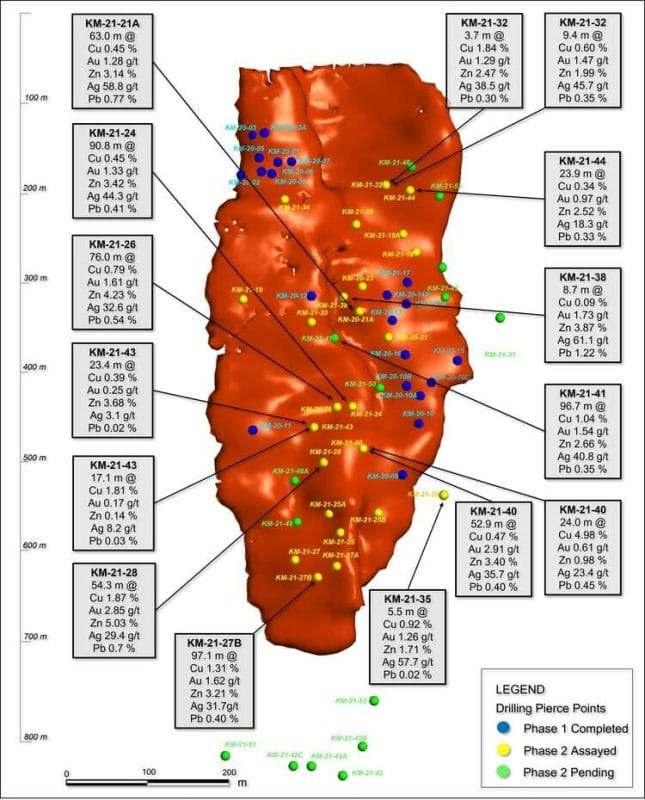
The (geological) models are a-changin
This last batch of results—wide, high-grade intervals—carry the potential to add significant tonnage outside of the historic resource block where Exxon Minerals defined two discrete mineralized zones—North and South—separated by 100 meters on strike.
Connecting the dots—demonstrating good (vertical) continuity—is the key to establishing positive economics in any underground mining scenario.
This Phase-2 campaign by Arizona Metals indicates that these two zones—North and South—are LINKED… NOT distinct as once thought.
This new model augments Kay’s tonnage potential.
This next map is a good one (nice one fellas). It depicts the two extremes generated via the business end of the drill bit—the shallowest and the deepest holes drilled to date.
Assays are pending for KM-21-46 (200 meters depth) and KM-21-42A (850 meters depth).
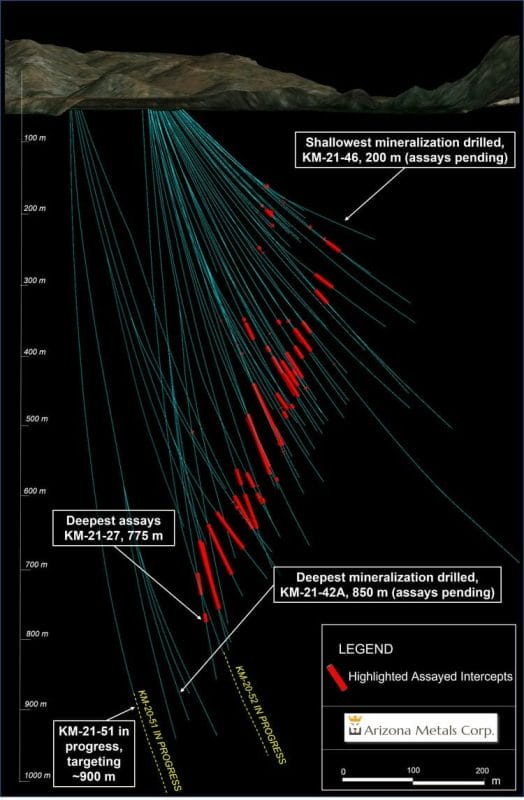
The Structural Mapping Campaign
Surface mapping is a valuable tool in teeing up drill targets at Kay.
As an Isoclinal Folded Deposit, the folded hinges of the deposit are the thickest sections of mineralization and represent the most compelling drill targets—targets that often demonstrate superior grades and widths.
Quinton Hennigh offers a good example of Kay’s Isoclinal folded geology comparing the underlying structure to that of a taffy pull (Hennigh talks Kay’s unique geology beginning at 26:40 via the video linked below)…
Crescat Gets Activist on Gold & Silver #32 – Arizona Metals Corp ($AMC.V)
This next pic demonstrates this folding characteristic at Kay, at surface. Note the ‘folding’ going on along the upper section of this outcropping rock…

In September 2021, the Company initiated a detailed surface structural mapping campaign to update and supplement structural mapping completed in 2019.

The results from this mapping program will be combined with core logging data to refine drill targets at pads 4, 5, and 6 (map below). These pads will test for mineralized extensions roughly 500 meters to the north and 300 meters south of the main mineralized body.
Other high-priority drill targets on the property—the Central and Western targets (C1 and C2 – W1 and W2 on the map below)—are located roughly 0.5 kilometers and 1.3 kilometers to the west of the Kay deposit. Surface mapping will also refine these targets for a proper probe with the drill bit early next year.
In a recent chat with CEO Pais, I learned that the Central targets can be drilled from pad 3 (permits to drill these highly prospective targets should arrive soon).
These regional targets represent a compelling speculative dynamic—an element of intrigue if you will—to this rapidly evolving (VMS) story. Both will see their subsurface layers probed during this Phase-2 campaign.
To fully appreciate this regional potential, note the scale on the map below.
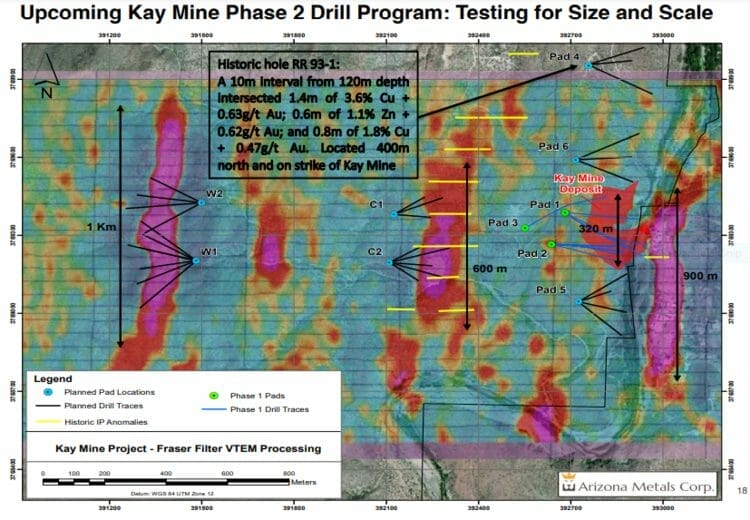
Marc Pais, CEO:
“The ten drill holes released today continue to demonstrate the richness and size potential of the Kay Mine system. Virtually all holes drilled to date at Kay have intersected semi-massive to massive sulphide mineralization, with assays pending on ten more holes, and three holes currently underway.
In Phase 2 the deposit has been drilled to 775 m below surface (in Hole 27) along a strike length of 300 m and drilling continues to expand Kay mineralization in all directions with assays pending on a number of holes up to 850 m below surface. Holes 40 and 41 were drilled to test above and below the high-grade intervals encountered in Holes 24, 26, and 28. Both Holes 40 and 41 demonstrate exceptional vertical continuity of thickness and grade in this portion of the deposit. Drilling is currently underway with three drill rigs to test for further extensions of high-grade mineralization, both laterally and targeting depths below 900 m.
Our geological model, especially the modeled orientation of mineralized zones, is evolving rapidly as we drill, and is confirming a deposit considerably larger than reported historically. Our drill program is evolving to reflect these changes, and we are currently drill testing a number of new targets both at depth and near surface.”
The Company is currently drilling with three rigs—three drill crews, 20 drillers, two onsite geos supervising activity—drilling twenty-four hours a day, seven days a week.
I suspect that by now, the Company is nearing the halfway point of this 75,000-meter campaign.
Three holes are being shipped off to the lab every month.
Lab turnaround is currently nine to ten weeks.
Final thought
The plot underpinning the Arizona Metals story is evolving rapidly. In a recent Guru offering, I speculated the following…
The narrative now becomes, how big can this thing get? Or, more precisely… could this turn into another United Verde? If the Company continues to encounter broad intervals of high-grade mineralization outside the historic resource block, the answer is an emphatic “YES”.
That remains my opinion. I suspect Arizona Metals will fall prey to a resource-hungry predator, one that will swoop in and take this project out at a fat premium to current price levels.
We stand to watch.
END
—Greg Nolan
Full disclosure: Arizona Metals is an Equity Guru marketing client.
*** The historic estimate has not been verified as a current mineral resource. None of the key assumptions, parameters, and methods used to prepare the historic estimate were reported, and no resource categories were used. Significant data compilation, re-drilling and data verification may be required by a “qualified person” (as defined in National Instrument 43-101 – Standards of Disclosure for Mineral Projects) before the historic estimate can be verified and upgraded to be a current mineral resource. A qualified person has not done sufficient work to classify it as a current mineral resource, and Arizona Metals is not treating the historic estimate as a current mineral resource.

